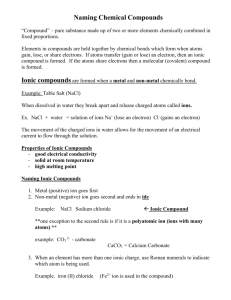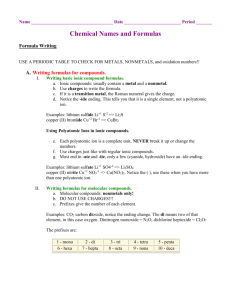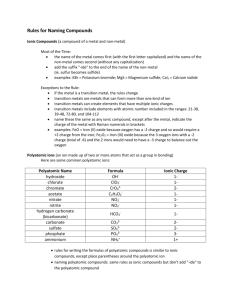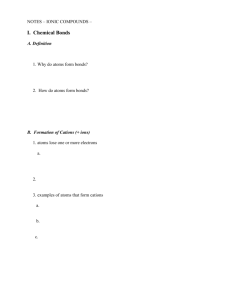NM NM = nonmetal -3 -2 -1 NM +1 +2 md = metalloid md NM NM
advertisement
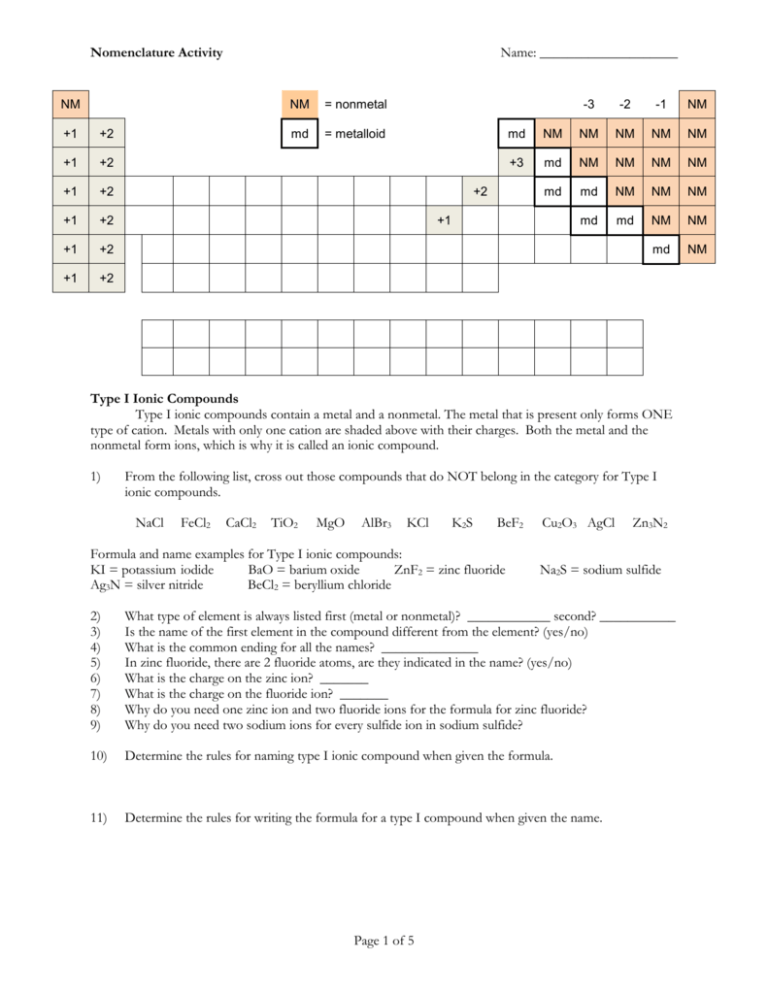
Nomenclature Activity Name: ____________________ NM +1 +2 +1 +2 +1 +2 +1 +2 +1 +2 +1 +2 NM = nonmetal md = metalloid -3 -2 -1 NM md NM NM NM NM NM +3 md NM NM NM NM md md NM NM NM md md NM NM md NM +2 +1 Type I Ionic Compounds Type I ionic compounds contain a metal and a nonmetal. The metal that is present only forms ONE type of cation. Metals with only one cation are shaded above with their charges. Both the metal and the nonmetal form ions, which is why it is called an ionic compound. 1) From the following list, cross out those compounds that do NOT belong in the category for Type I ionic compounds. NaCl FeCl2 CaCl2 TiO2 MgO AlBr3 KCl K2S BeF2 Formula and name examples for Type I ionic compounds: KI = potassium iodide BaO = barium oxide ZnF2 = zinc fluoride Ag3N = silver nitride BeCl2 = beryllium chloride Cu2O3 AgCl Zn3N2 Na2S = sodium sulfide 2) 3) 4) 5) 6) 7) 8) 9) What type of element is always listed first (metal or nonmetal)? ____________ second? ___________ Is the name of the first element in the compound different from the element? (yes/no) What is the common ending for all the names? ______________ In zinc fluoride, there are 2 fluoride atoms, are they indicated in the name? (yes/no) What is the charge on the zinc ion? _______ What is the charge on the fluoride ion? _______ Why do you need one zinc ion and two fluoride ions for the formula for zinc fluoride? Why do you need two sodium ions for every sulfide ion in sodium sulfide? 10) Determine the rules for naming type I ionic compound when given the formula. 11) Determine the rules for writing the formula for a type I compound when given the name. Page 1 of 5 12) Name each of the type I ionic compounds listed in question 1. __________________________________ ________________________________________ __________________________________ ________________________________________ __________________________________ ________________________________________ __________________________________ ________________________________________ __________________________________ Type II Ionic Compounds Type II ionic compounds also contain a metal and a nonmetal however the metal that is present here can form more than one type of cation. Metals with multiple possible charges are listed in the periodic table as blank. Type II metals are NOT Type I metals. Again, both the metal and the nonmetal form ions, and it is still called an ionic compound. These metals usually only form two different ions. 1) From the following list, cross out those compounds that do NOT belong in the category for Type II ionic compounds. AlP FeCl2 Ag2O VBr5 CoS SnF2 K3N SrF2 CuBr AuCl3 ZnO HgS Formula and name examples for Type II ionic compounds: Fe2O3 = iron(III) oxide or ferric oxide FeO = iron(II) oxide or ferrous oxide CuS = copper(II) sulfide or cupric sulfide CuCl = copper(I) chloride or cuprous chloride MnO2 = manganese(IV) oxide or manganic oxide MnCl2 = manganese(II) chloride or manganous chloride 2) 3) 4) 5) 6) 7) 8) 9) 10) What type of element is always listed first (metal or nonmetal)? ____________ second? ___________ Is the name of the first element in the compound different from the element? (yes/no) What is the common ending for the nonmetal portion of the names? ______________ In the compound FeO, what is the charge on iron? _______ In the compound Fe2O3, what is the charge on iron? ________ What does the Roman number after the metal name represent? When the metal name ends in –ic, to what ion does it refer? (higher charge/lower charge) When the metal name ends in –ous, to what ion does it refer? (higher charge/lower charge) Determine the rules for naming type II ionic compound when given the formula. 11) Determine the rules for writing the formula for a type II compound when given the name. 12) Name each of the type II ionic compounds listed in Question 1 of Type II section. __________________________________ ________________________________________ __________________________________ ________________________________________ __________________________________ ________________________________________ __________________________________ Page 2 of 5 Molecular Compounds Binary compounds that do not contain metals have covalent bonds instead of ionic bonds. A covalent bond is formed by sharing one or more pairs of electrons. The pair of electrons is shared by both atoms. For example, in forming H2, each hydrogen atom contributes one electron to the single bond. 1) From the following list, cross out those compounds that do NOT belong in the category for molecular compounds which contain only nonmetals or metalloids. CCl4 AlCl3 CO SeF6 SiO2 SrI2 P4O10 TiO2 SeO3 IrCl ZrO2 N2O5 Formula and name examples for molecular compounds: CO2 = carbon dioxide H2O = dihydrogen monoxide IF5 = iodine pentafluoride BF3 = boron trifluoride 2) 3) 7) Which element is listed first in the name? Is the name of the first element in the compound different from the element? (yes/no) What is the common ending for all the names? ______________ What do the prefixes (di-, mono-, penta-, tri-) in the names above mean? Is the prefix mono- used when there is only one atom of the first element? (yes/no) Is the prefix mono- used when there is one atom of the second element? (yes/no) As a team, determine the rules for naming type III binary ionic compound when given the formula. 8) Name each of the molecular compounds listed above. 4) 5) 6) __________________________________ ________________________________________ __________________________________ ________________________________________ __________________________________ ________________________________________ __________________________________ Compounds Containing Polyatomic Ions Polyatomic ions are ions that as a group have a set charge. Polyatomic ions are usually recognized in a formula by the grouping of more than one nonmetal elements after a metal. Your book has a table listing polyatomic ions. Use your book’s table to fill in the following table with the appropriate names/formulas of the polyatomic ions or use the table in the power point presentation. Name Formula Name ammonium Formula chlorite nitrate C2H3O2-1 NO2-1 CrO4-2 OH-1 carbonate cyanide SO3-2 Page 3 of 5 Polyatomic ions containing oxygen (oxyanions) are somewhat special. carbonate = CO3-2 1) Match the location of carbon on the periodic table with the two figures on the right. 2) What number is in the carbon location on the left figure? To what does this number refer? 3) What number is the carbon location on the right figure? To what does this number refer? 4) What element must all oxyanions contain? 5) What is the ending of the name of the ion determined from these tables? 6) Determine the formula for the following oxyanions using the figures above. Phosphate _________ Silicate ________ Bromate ________ perchlorate = ClO4¯ chlorate = ClO3¯ Iodate ________ Sulfate ________ Nitrate ________ chlorite = ClO2¯ hypochlorite = ClO¯ 7) When comparing the oxyanions above, is the charge of the chlorate ion the same as the charge for the other chloro-oxyanions? 8) How many less oxygen atoms does chlorite have compared to chlorate? 9) How many more oxygen atoms does perchlorate have compared to chlorate? 10) How many less oxygen atoms does hypochlorite have compared to chlorate? 11) What name ending(s) can help you identify the presence of an oxyanion in a compound? 12) If sulfate is SO4-2, what would the formula for sulfite be? Page 4 of 5 13) In the table below, fill in the name and formula for the oxyanions in the shaded column. Use the figures on the previous page 14) In the table below, fill in the name and formula for the rest of the oxyanions. Element per-___ -ate ion ____-ate ion _____-ite ion hypo-____-ite ion Bromine (Br) Iodine (I) Phosphorus (P) Nitrogen (N) Use your knowledge of Type I and Type II metals as well as the appropriate polyatomic name/formula to fill in the following table. Name Formula Name sodium carbonate Formula Cu(NO2)2 iron(II) nitrate calcium sulfate MnSO4 ammonium nitrate Ca(ClO)2 KCN Check your work: Were the polyatomic ions correctly identified for the above table? Remember when you have parentheses, you must identify the polyatomic ions by looking inside the parentheses and the numbers outside the parentheses just indicate how many of that polyatomic ion you have. Are the compound formulas you filled into the table above neutral in charge? Do all type II metals in the table above have their charge indicated by either a Roman numeral or their Latin name with an –ous or –ic ending? Are all type I metals listed without a Roman numeral? Page 5 of 5

